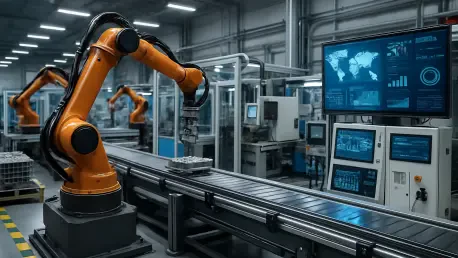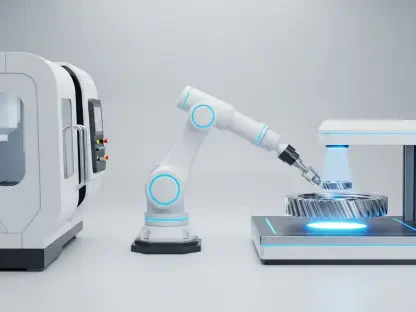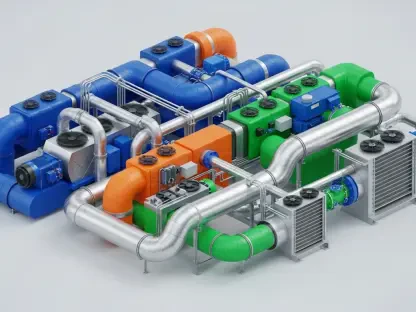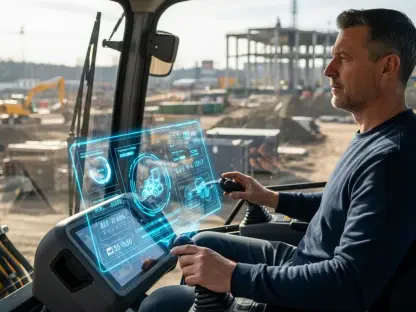The fourth industrial revolution, often termed Industry 4.0, is fundamentally altering the global industrial landscape through an unprecedented wave of digital transformation, integrating cutting-edge technologies into everyday operations. This transformative era incorporates innovations such as private 5G networks, industrial Internet of Things (IIoT), automation, robotics, and cloud computing into the fabric of diverse sectors. From bustling manufacturing plants to critical public safety systems, these advancements are unlocking remarkable levels of efficiency and productivity that were once unimaginable. The momentum behind Industry 4.0 is not merely a fleeting trend but a robust movement reshaping how industries function and compete on a worldwide scale. Forecasts from leading industry analysts underscore this shift, projecting that Industry 4.0 revenues could soar to $1.6 trillion by 2030 with a compound annual growth rate (CAGR) of 19.4%. This article delves into the core drivers of this revolution, examining the technologies propelling change, their rapid growth trajectories, and their profound impacts across a multitude of industries, while highlighting regional dynamics and policy influences that fuel adoption.
Harnessing Connectivity and Automation for Progress
The foundation of Industry 4.0 rests on the seamless integration of connectivity and automation, with private 5G networks standing out as a pivotal enabler. These networks deliver high-speed, low-latency communication essential for real-time applications such as monitoring and control in industrial settings. Their adoption is accelerating at an impressive pace, with spending expected to reach $5 billion by 2028, reflecting a CAGR of 41%. Reports indicate efficiency improvements ranging from 20 to 90% in manufacturing and logistics, alongside substantial cost reductions in operations like rail terminals, where savings can be as high as 40%. This shift from niche to mainstream technology is redefining operational models, allowing industries to respond swiftly to dynamic market demands. Beyond mere speed, private 5G ensures reliability in environments where downtime is not an option, positioning it as a cornerstone of modern industrial transformation that promises to sustain growth and innovation across multiple domains.
Automation, driven by IIoT and robotics, complements connectivity by enhancing operational precision and addressing pressing challenges. IIoT, which captured a 39.3% market share last year, empowers industries with connected systems that facilitate predictive maintenance and data-driven decision-making. Robotics, on the other hand, tackles labor shortages exacerbated by aging populations, delivering productivity gains with labor cost savings of up to 55% in warehousing alone. These technologies also contribute to safer workplaces and reduced environmental footprints, notably in high-risk sectors like oil refineries, where automation minimizes worker exposure to hazards and cuts emissions. The synergy between IIoT and robotics is not just about replacing human effort but optimizing it, ensuring that industries can scale operations while maintaining high standards of safety and sustainability. This dual approach is proving indispensable as businesses navigate an increasingly complex global economy with heightened expectations for efficiency and responsibility.
Revolutionizing Communication Across Sectors
Push-to-talk (PTT) technologies are emerging as a critical component of Industry 4.0, bridging communication gaps in both high-stakes and routine industrial scenarios. Originally rooted in public safety and emergency response, PTT has evolved to encompass broadband and mission-critical applications, with revenues projected to hit $12 billion by 2028 at a CAGR of 11%. This growth is fueled by demand in sectors like transport and logistics, where instant, reliable communication is vital for coordinating complex operations. Unlike traditional systems, modern PTT solutions integrate seamlessly with digital platforms, offering enhanced clarity and coverage that ensure teams remain connected even in remote or challenging environments. This adaptability highlights PTT’s expanding role beyond crisis management, positioning it as a tool for everyday efficiency that supports the broader goals of digital transformation in industrial communication.
The versatility of PTT technologies is further evidenced by their adoption across a wide range of industries, each leveraging the tool for unique needs. In public safety, systems like these ensure first responders can coordinate effectively during emergencies, while in logistics, they streamline workflows by enabling real-time updates among dispersed teams. The transition to broadband PTT also means richer data sharing, such as location tracking and multimedia, which enhances situational awareness in dynamic settings. As industries increasingly rely on interconnected systems, the ability to maintain clear, uninterrupted communication becomes a competitive advantage. This trend reflects a broader shift toward integrated solutions within Industry 4.0, where communication is not just a function but a strategic asset that drives operational success. The ongoing expansion of PTT applications underscores its potential to redefine how industries manage both routine tasks and critical challenges in an era of digital evolution.
Navigating Regional Dynamics and Policy Impacts
Regional disparities in the adoption of Industry 4.0 technologies reveal intriguing patterns of leadership and innovation. China has taken a commanding lead in private 5G deployment, supported by extensive state-funded initiatives and large-scale installations of radio access network nodes. This aggressive push has positioned the country as a frontrunner in connectivity infrastructure, enabling rapid industrial upgrades. In contrast, North America spearheads broader Industry 4.0 adoption, driven by substantial investments in research and development and a robust technological ecosystem anchored by major players like Microsoft and Amazon. These differing approaches—state-driven in China versus innovation-led in North America—illustrate how local contexts shape the pace and nature of digital transformation. Such variations emphasize the importance of tailored strategies that align with regional strengths and priorities to maximize the benefits of these advancements.
Policy frameworks play an equally crucial role in accelerating the spread of Industry 4.0 technologies across the globe. Spectrum liberalization, particularly the allocation of mid-band frequencies for industrial use, has been a game-changer in countries like the US, Germany, and Japan. This policy enables enterprises to establish dedicated networks customized to their operational requirements, fostering innovation and scalability. Additionally, government funding for digital infrastructure and robotics, especially prominent in North America and China, acts as a catalyst for market expansion. These supportive measures ensure that businesses, regardless of size, can access the tools needed to compete in a digitally driven landscape. The interplay between policy and technology adoption highlights a critical truth: sustained progress in Industry 4.0 depends not only on innovation but also on an enabling environment that encourages investment and mitigates barriers to implementation.
Expanding Horizons Across Diverse Verticals
Industry 4.0 technologies are not confined to a single sector but are permeating a wide array of industries, each adapting these tools to unique challenges. Manufacturing and warehousing remain at the forefront, leveraging private 5G and automation to optimize production lines and supply chains with remarkable efficiency gains. However, significant growth is also evident in less traditional areas such as railways, healthcare, mining, and military applications. In railways, for instance, real-time data from connected systems enhances operational reliability, while in healthcare, IoT devices improve patient outcomes through better monitoring and resource allocation. This broad applicability demonstrates how digital transformation transcends industry boundaries, offering solutions that are as varied as the problems they address. The ripple effect of such widespread adoption is poised to redefine operational benchmarks globally.
Beyond the obvious sectors, the impact of Industry 4.0 is reshaping even niche applications with profound implications. In mining, technologies like IIoT enable remote monitoring of equipment and worker safety, reducing accidents in hazardous environments. Military operations benefit from secure, high-speed networks that ensure seamless communication in critical missions. These diverse use cases underscore the adaptability of digital tools, which can be customized to meet specific needs while delivering consistent value in terms of efficiency and safety. As more industries recognize the transformative potential of these technologies, the momentum behind Industry 4.0 continues to build, promising a future where digital integration is the norm rather than the exception. This cross-sectoral influence signals a paradigm shift, where the benefits of digital transformation are accessible to all, driving innovation and resilience across the global industrial spectrum.
Reflecting on a Digitally Transformed Landscape
Looking back, the journey of Industry 4.0 reveals a remarkable transformation in how industries operate, driven by the integration of private 5G, PTT, and a suite of advanced technologies. The explosive growth witnessed in these areas has redefined productivity, with efficiency gains becoming a hallmark of digitally enabled operations. Regional leadership, from China’s state-supported connectivity to North America’s innovation-driven ecosystem, showcases diverse paths to progress, while supportive policies lay the groundwork for widespread adoption. Moving forward, industries must focus on bridging skill gaps and investing in training to fully harness these tools. Collaboration between governments, businesses, and educational institutions will be key to addressing labor challenges and ensuring sustainable growth. As the digital landscape continues to evolve, staying agile and adaptable will remain essential for leveraging the full potential of this industrial revolution.









